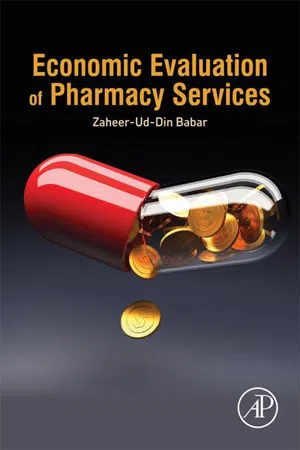
- 248 pages
- English
- ePUB (mobile friendly)
- Available on iOS & Android
Economic Evaluation of Pharmacy Services
About This Book
Economic Evaluation of Pharmacy Services provides the latest on the trend to a more product-centered and service-centered practice, eschewing traditional economic evaluation techniques that focus on product-to-product comparisons in favor of evaluating processes that measure costs and health outcomes.
Complete with examples focusing on best practices, including various study designs, types of pharmacy services, and types of outcomes being evaluated, the book emphasizes case studies and examples that help readers understand economic evaluation techniques. Many of these techniques are transferable across countries, especially where there are advanced and stable health systems in place. With the help of this practical guide, readers will gain a thorough understanding of the application of economic evaluation of pharmacy services.
- Delivers a practical guide for conducting economic evaluations of hospital and community pharmacy services
- Documents the literature around health economic evaluation and innovative pharmacy services
- Guides the development of a standardized health economic evaluation tool to evaluate these services
Frequently asked questions
Information
An Introduction to Economic Evaluation of Health Care Programs
Abstract
Keywords
Rationale for Economic Evaluation

| Country | Δ 1990–95 | Δ 1995–2000 | Δ 2000–05 | Δ 2005–10 | Δ 2010–15 |
| Australia | 0.4 | 0.7 | 0.4 | 0.5 | 0.8 |
| Austria | 1.2 | 0.3 | 0.4 | 0.5 | 0.2 |
| Belgium | 0.4 | 0.5 | 1.1 | 0.9 | 0.4 |
| Canada | 0.2 | −0.3 | 0.8 | 1.6 | −0.5 |
| Denmark | −0.3 | 0.3 | 1.0 | 1.4 | 0.1 |
| Finland | 0.1 | −0.5 | 1.2 | 0.9 | 0.8 |
| France | 1.9 | −0.3 | 0.6 | 0.5 | 0.3 |
| Germany | 1.4 | 0.3 | 0.4 | 0.8 | 0.1 |
| Greece | 1.9 | −0.7 | 1.8 | 0.9 | −1.6 |
| Ireland | 0.5 | −0.2 | 1.8 | 2.9 | −1.3 |
| Italy | −0.1 | 0.7 | 0.8 | 0.6 | 0.1 |
| Japan | 0.6 | 1.0 | 0.7 | 1.4 | 1.7 |
| Netherlands | 0.3 | −0.3 | 2.4 | 1.0 | 0.3 |
| Norway | 0.2 | 0.4 | 0.6 | 0.6 | 1.0 |
| Spain | 0.9 | −0.2 | 0.9 | 1.3 | −0.0 |
| Sweden | 0.0 | 0.1 | 0.9 | 0.2 | 2.6 |
| Switzerland | 1.5 | 0.5 | 0.9 | 0.2 | 1.1 |
| United Kingdom | 1.0 | 0.2 | 1.2 | 1.0 | 1.3 |
| Mean value | 0.7 | 0.1 | 1.0 | 1.0 | 0.4 |
| United States | 1.2 | 0.0 | 2.0 | 1.8 | 0.5 |
Economic Evaluation: Costs, Outcomes, Techniques
Table of contents
- Cover image
- Title page
- Table of Contents
- Copyright
- Dedication
- Contributors
- Foreword
- Preface
- Chapter 1. An Introduction to Economic Evaluation of Health Care Programs
- Chapter 2. Economic Evaluation of Community and Hospital Pharmacy Services: An Introductory Review
- Chapter 3. Economic Evaluation of Pharmacy Services: Review of Studies From Asia, Africa, and South America
- Chapter 4. Economic Evaluation and Its Types
- Chapter 5. Design Principles for Economic Evaluations in Pharmacy
- Chapter 6. Steps in Conducting an Economic Evaluation
- Chapter 7. Evaluation of the Community Pharmacist-led Anticoagulation Management Service (CPAMS) Pilot Program in New Zealand
- Chapter 8. Economic Evaluation of Pharmacy Services in Portugal
- Chapter 9. Economic Evaluation of Pharmacist-Managed Warfarin Therapy: A Review of Studies
- Chapter 10. Economic Evaluation of a Medicines Management Model in New Zealand: A Proposal
- Index
